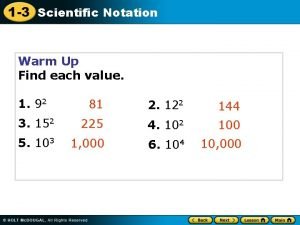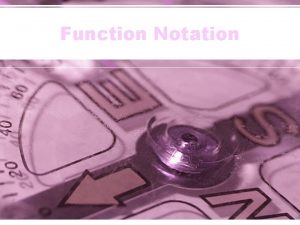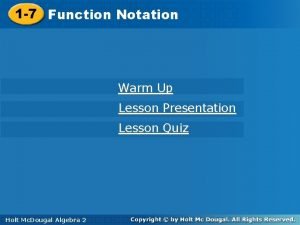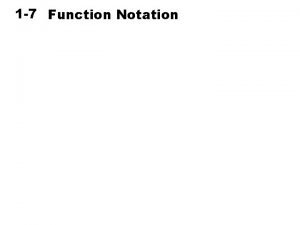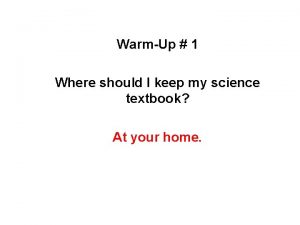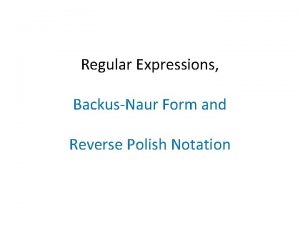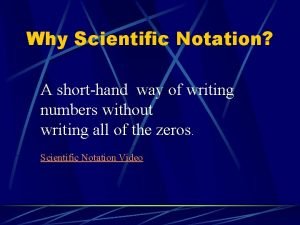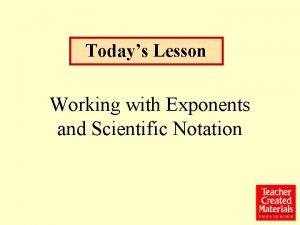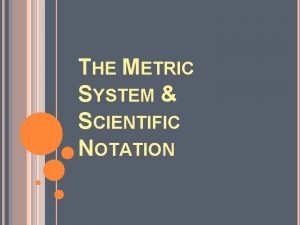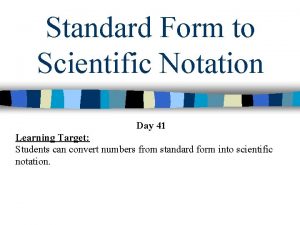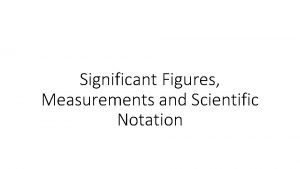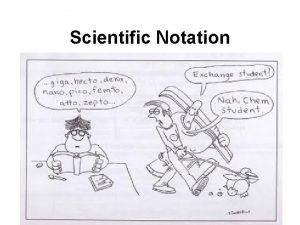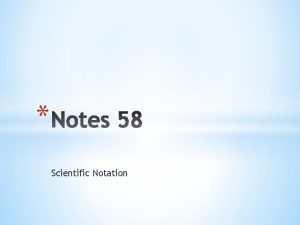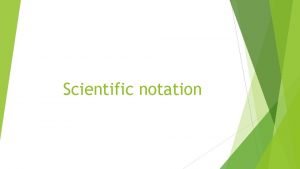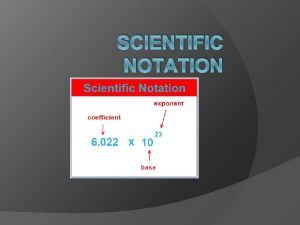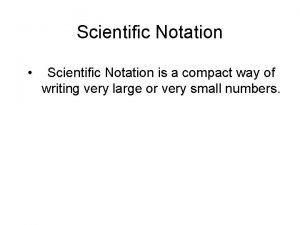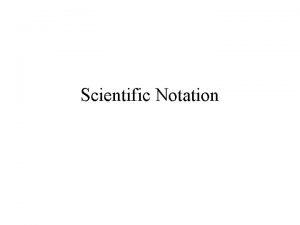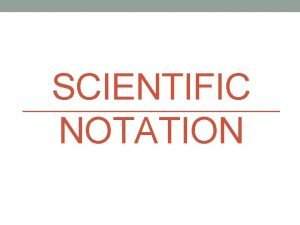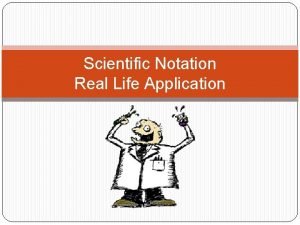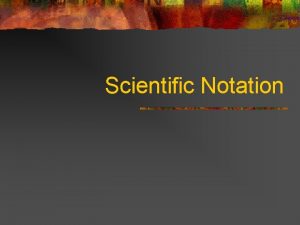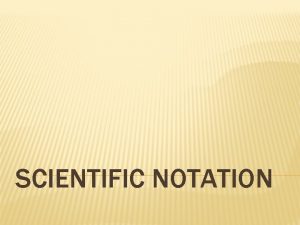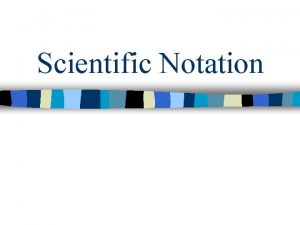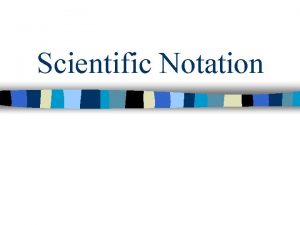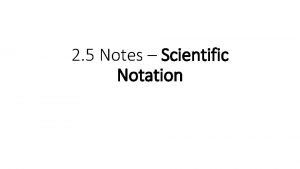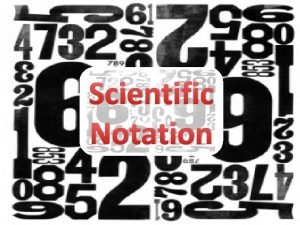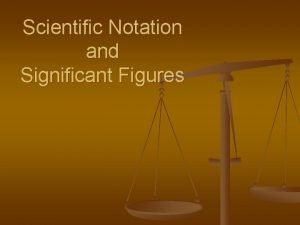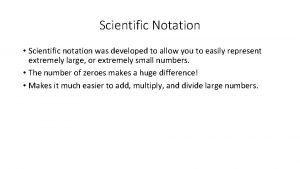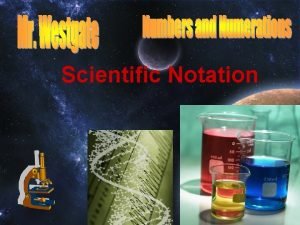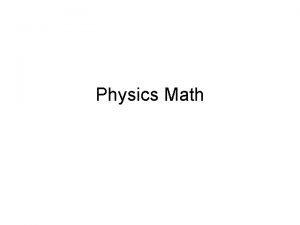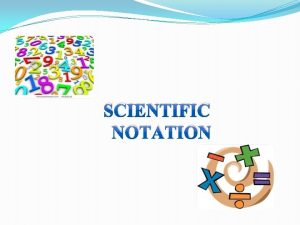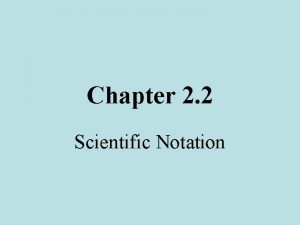1 3 Scientific Notation Warm Up Find each























- Slides: 23

1 -3 Scientific Notation Warm Up Find each value. 1. 92 81 2. 122 144 3. 152 225 4. 102 100 5. 103 1, 000 6. 104 10, 000

1 -3 Scientific Notation Problem of the Day Each day, Lowell runs one more lap than he did the day before. After seven days he has run a total of 77 laps. How many laps did he run on the first day? 8

1 -3 Scientific Notation Learn to multiply by powers of ten and express numbers in scientific notation.

1 -3 Scientific Notation Vocabulary scientific notation

1 -3 Scientific Notation The distance from Venus to the Sun is over 100, 000 kilometers. You can write this number as a power of ten by using a base of ten and an exponent. 10 · 10 · 10 = 108 Power of ten

1 -3 Scientific Notation The table shows several powers of ten. Power of 10 Meaning Value 101 10 10 102 10 · 10 103 10 · 10 1, 000 104 10 · 10 10, 000

1 -3 Scientific Notation Additional Example 1 A: Multiplying by Powers of Ten Multiply 14 · 103. Method 1: Evaluate the power. 14 · 103 = 14 · (10 · 10) = 14 · 1, 000 = 14, 000 Multiply 10 by itself 3 times. Multiply.

1 -3 Scientific Notation Additional Example 1 B: Multiplying by Powers of Ten Multiply 14 · 103. Method 2: Use mental math. 14 · 103 = 14. 000 3 places = 14, 000 Move the decimal point 3 places. (You will need to add 3 zeros. )

1 -3 Scientific Notation Check It Out: Example 1 A Multiply 12 · 102. Method 1: Evaluate the power. 12 · 102 = 12 · (10 · 10) = 12 · 100 = 1, 200 Multiply 10 by itself 2 times. Multiply.

1 -3 Scientific Notation Check It Out: Example 1 B Multiply 12 · 102. Method 2: Use mental math. 12 · 102 = 12. 00 2 places = 1, 200 Move the decimal point 2 places. (You will need to add 2 zeros. )

1 -3 Scientific Notation Scientific notation is a kind of shorthand that can be used to write large or small numbers. Numbers expressed in scientific notation are written as the product of two factors. In scientific notation, 17, 900, 000 is written as A number greater than or equal to 1 but less than 10 A power of 10

1 -3 Scientific Notation Writing Math In scientific notation, it is customary to use a multiplication cross ( ) instead of a dot.

1 -3 Scientific Notation Additional Example 2: Writing Numbers in Scientific Notation Write the number 4, 340, 000 in scientific notation. 6 places Move the decimal point to 4, 340, 000 = 4, 340, 000 get a number that is greater than or equal to 1 and less than 10. = 4. 34 106 The exponent is equal to the number of places the decimal point is moved.

1 -3 Scientific Notation Check It Out: Example 2 Write the number 8, 421, 000 in scientific notation. 6 places 8, 421, 000 = 8. 421 106 Move the decimal point to get a number that is greater than or equal to 1 and less than 10. The exponent is equal to the number of places the decimal point is moved.

1 -3 Scientific Notation Additional Example 3: Writing Numbers in Standard Form The population of China in the year 2000 was estimated to be about 1. 262 109. Write this number in standard form. Since the exponent 1. 262 109 = 1. 262000000 is 9, move the decimal point 9 places to the right. = 1, 262, 000 The population of China was about 1, 262, 000 people.

1 -3 Scientific Notation Check It Out: Example 3 The distance from the Earth to the Sun is calculated to be 1. 5 108 kilometers. Write this distance in standard form. 1. 5 108 = 1. 50000000 Since the exponent is 8, move the decimal point 8 places to the right. = 150, 000 The distance from the Earth to the Sun is about 150, 000 kilometers.

1 -3 Scientific Notation Additional Example 4: Comparing Numbers in Scientific Notation In 2005, the population of Mexico was 1. 06 108 and the population of Brazil was 1. 86 108. In which country do more people live? To compare numbers written in scientific notation, first compare the exponents. If the exponents are equal, then compare the decimal portion of the numbers. Mexico: 1. 06 108 Brazil: 1. 86 108 Notice that 1. 06 < 1. 86. So 1. 06 108 < 1. 86 108 Brazil has more people living there.

1 -3 Scientific Notation Check It Out: Additional Example 4 The number of coins in Ty’s jar was 0. 76 104 and number of coins in Laurel’s jar was 0. 93 103. In which jar are there more coins? To compare numbers written in scientific notation, first compare the exponents. If the exponents are equal, then compare the decimal portion of the numbers. Ty’s jar: 0. 76 104 Laurel’s jar: . 93 103 Notice that 4 > 3. So. 76 104 >. 93 103 Ty’s jar has more coins in it.

1 -3 Scientific Notation Lesson Quizzes Lesson Quiz

1 -3 Scientific Notation Lesson Quiz for Student Response Systems 1. Multiply. 62 · 102 A. 6, 200 B. 620 C. 1, 240 D. 0. 62

1 -3 Scientific Notation Lesson Quiz for Student Response Systems 2. Multiply. 220 · 102 A. 44, 000 B. 4, 400 C. 22, 000 D. 2, 200

1 -3 Scientific Notation Lesson Quiz for Student Response Systems 3. Which of the following represents 6, 500, 000 in scientific notation? A. 6. 5 105 B. 6. 5 106 C. 65 105 D. 65 106

1 -3 Scientific Notation Lesson Quiz for Student Response Systems 4. The distance to the moon is about 3. 6 105 km from the earth. Which of the following represents this number in standard form? A. 3, 600, 000 B. 1, 800, 000 C. 360, 000 D. 180, 000
 Scientific notation
Scientific notation Micro engineering notation
Micro engineering notation Function notation warm up
Function notation warm up Function notation lesson
Function notation lesson Use the graph of ƒ to find ƒ(2).
Use the graph of ƒ to find ƒ(2). Slimotosis
Slimotosis Evaluate the following prefix expression:
Evaluate the following prefix expression: Reversed polish notation
Reversed polish notation Polish notations
Polish notations Scientific notation
Scientific notation 71 000 in scientific notation
71 000 in scientific notation Ladder method physics
Ladder method physics 97 000 000 in scientific notation
97 000 000 in scientific notation 87 pg in scientific notation
87 pg in scientific notation Incorrect scientific notation examples
Incorrect scientific notation examples Scientific notation vocabulary words
Scientific notation vocabulary words Express 4,980,000, 000 in scientific notation
Express 4,980,000, 000 in scientific notation Rules of scientific notation
Rules of scientific notation 67x10^6 in scientific notation
67x10^6 in scientific notation Standard form scientific notation
Standard form scientific notation Scientific notation numbers
Scientific notation numbers What is scientific notation
What is scientific notation Scientific notation in everyday life
Scientific notation in everyday life Irrational numbers notation
Irrational numbers notation
